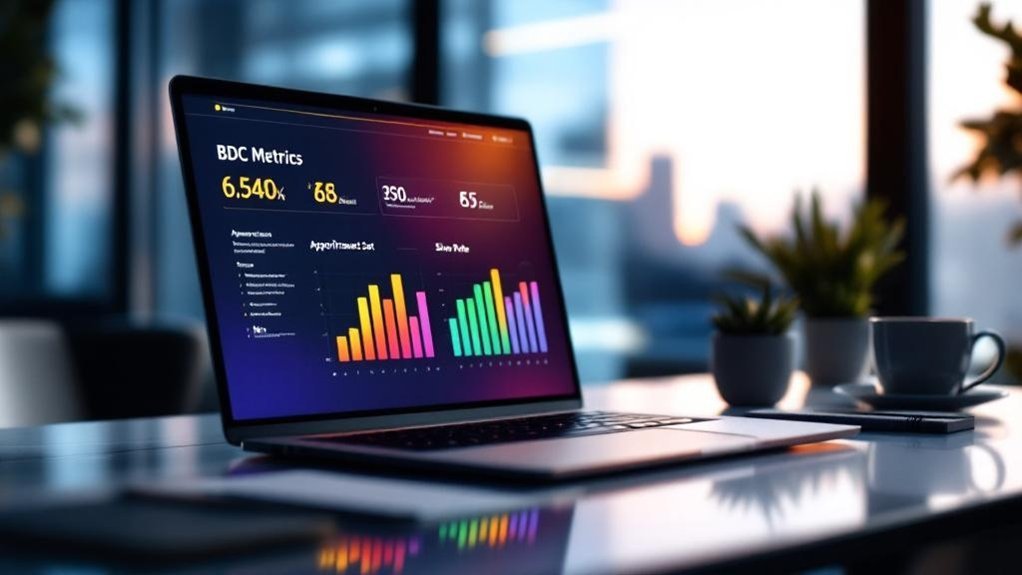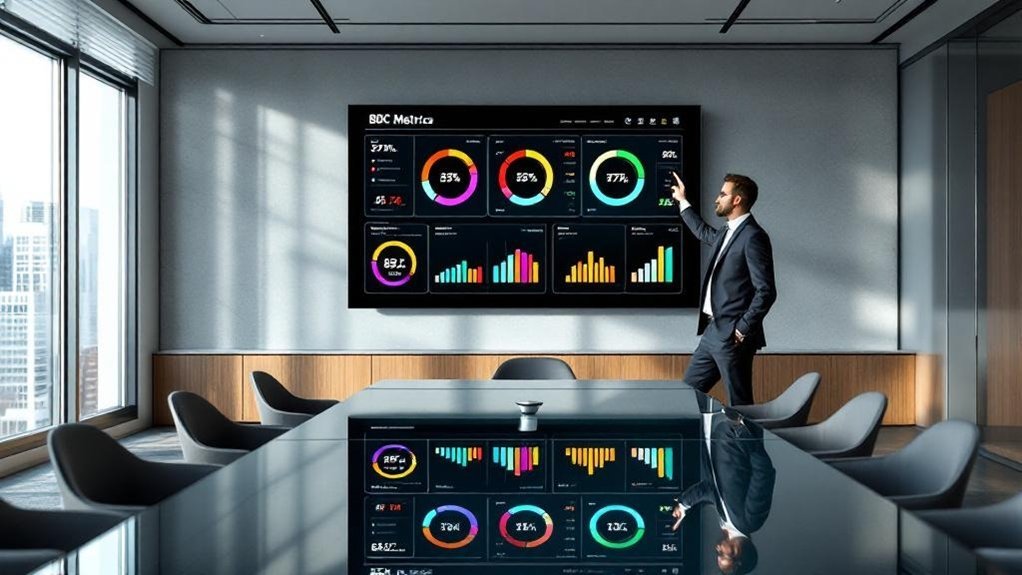You should track seven BDC metrics that turn leads into predictable revenue: lead volume and source attribution, lead qualification and conversion rate, rapid lead response time, appointment set and show rates, agent productivity and outbound activity, contact and call drop rates, and cost per lead with ROI. Use these metrics to prioritize high-value channels, coach agents, and reallocate budget based on CPL and conversion performance. Keep monitoring them and you’ll uncover clear levers to boost efficiency and sales.
Key Takeaways
- Lead volume and source attribution: track monthly lead counts and channel ROI to prioritize high-quality acquisition sources.
- Lead qualification and conversion rate: measure percentage of leads qualified and converted to appointments or sales (target 20–40%).
- Response time and appointment set/show rates: aim for 70%).
- Agent productivity and outbound activity: monitor individual call volume, talk time, follow-ups, and outbound quotas to optimize performance.
- Operational efficiency and CPL/ROI: track cost per lead ($150–$300 benchmark) and ROI (≥1.20) to reallocate budget and improve profitability.
Lead Volume and Source Attribution

Think of lead volume as your BDC’s fuel gauge: you want hundreds to a few thousand leads per month depending on your market and store size, because that range gives you the statistical runway to hit sales targets. You’ll monitor lead volume alongside lead source attribution to see which channels drive quality prospects — digital platforms often dominate, but CRM tagging and tracking metrics prove it. Given typical website conversion of 1–3%, you’ll prioritize optimizing pages and campaigns that lift that rate. Treat BDC performance metrics as a system: higher volume without insight wastes effort. Use conversion rates and lead qualification rate benchmarks (20–40%) to allocate resources, test sources, and refine messaging so your pipeline stays predictable and profitable.
Lead Qualification and Conversion Rate
A clear, measurable lead qualification and conversion process is the linchpin of a profitable BDC: you should be qualifying 20–40% of inbound leads and then closely tracking what percentage of those qualified prospects convert to appointments or sales. Monitor lead qualification rate to validate your screening criteria and tie conversion rate back to specific lead management strategies. Focus spend and coaching on high-converting lead sources, and use data to identify where drop-off occurs between qualification and sale. Prompt response times and personalized follow-ups both lift conversion metrics, so embed them in scripts and workflows without delay. Regularly review these KPIs to pinpoint training gaps, optimize follow-up cadences, and drive sustained improvements in sales performance across your BDC.
Lead Response Time

You should set clear response speed targets—ideally under 5 minutes, with a hard goal under 10—to capture the highest-converting prospects within that critical first hour. Implement first-contact strategies like prioritized routing and scripted outreach to lift contact rates by up to 30% and convert more leads. Track response-time benchmarks to spot bottlenecks, guide agent coaching, and prove ROI from process changes.
Response Speed Targets
Speed matters: responding to a lead within the first hour—and ideally under five minutes—dramatically improves your chances of conversion, while delays beyond ten minutes cause conversion rates to plummet. Set clear response speed targets that tie lead response time to conversion metrics and appointment set rate. You’ll use these targets to diagnose bottlenecks in the BDC team, prioritize staffing, and focus coaching where delays occur. Track trends daily and weekly so metrics that every manager reviews highlight systemic issues versus individual performance. Faster responses boost customer experience and lift conversion consistently, improving ROI across the overall dealership. Make response speed a KPI, review it in performance meetings, and adjust targets as you optimize workflows.
First-Contact Strategies
When prospects get contacted within minutes—not hours—you’ll see conversion and appointment rates climb, because data shows leads reached in under five minutes outperform later replies by a wide margin. You should set a hard target for lead response time under five minutes, since studies show first responders capture roughly 78% of buyers. Treat BDC protocols as the spine of lead management: automate initial touches, route hot leads immediately, and empower agents to convert quickly. Metrics matter — tracking response times exposes bottlenecks and guides targeted coaching that lifts team performance. Use concise dashboards to monitor contact windows and appointment conversion trends, then run short sprints to improve weak links. Prioritize speed without sacrificing personalization to win more appointments.
Tracking & Benchmarks
Having nailed first-contact tactics, it’s time to measure how fast those touches actually happen—lead response time is the metric that turns good intentions into predictable results. You should aim for under 15 minutes, and ideally within the first hour; contacting leads in five minutes can multiply conversion rate dramatically versus waiting 30+ minutes. Track response by agent to spot BDC training gaps and lift team performance, using trends to tweak staffing and process flows. Monitor contact rate and appointment show rate alongside response time to see real impact.
- Measure average and median response time daily.
- Flag outliers per agent for targeted BDC training.
- Correlate response time with conversion rate and appointment show rate.
These are metrics every dealership needs.
Appointment Set and Show Rate

You should track appointment set efficiency to know what percentage of leads become scheduled visits and where reps are losing momentum. Use targeted reminder and confirmation tactics—texts, emails, and value-focused call scripts—to push show rates toward the 60–80% benchmark. Coach on objection handling and implement no-show reduction strategies so you can measurably lift conversion and reduce wasted capacity.
Appointment Set Efficiency
Why does appointment set efficiency matter to your bottom line? You’ll track appointment set rate and appointment show rate to quantify how well leads become showroom visits and actual customer attendance. BDC managers use these metrics to spot gaps in outreach strategies and reduce no-show occurrences, lifting showroom traffic and sales conversions.
- Measure: benchmark set rates (30–50%) and show rates (>70%) to prioritize coaching.
- Analyze: correlate outreach channels with customer attendance to refine scripts and timing.
- Act: target low performers with training and process tweaks to boost both set and show rates.
This data-driven focus turns missed opportunities into predictable visits, improving efficiency, accountability, and profitability without wasting resources.
Reminder & Confirmation Tactics
Because reminders bridge the gap between a set appointment and an actual showroom visit, a disciplined, multi-channel confirmation strategy is one of the fastest levers you can pull to lift show rates and revenue. You should deploy reminder tactics that mix phone, text and email to boost appointment show rates—texts and emails alone measurably increase customer engagement and reduce no-shows. Confirm value in each touch, offer easy rescheduling, and use automated reminder systems to hit contacts within the first hour of booking. Track outcomes with attendance tracking and analyze which channels and messages convert best. High-performing BDCs sustain 70%+ appointment show rates by iterating on reminder copy, cadence and timing, letting data drive continuous improvement.
No-Show Reduction Strategies
When teams combine automated text and email reminders with value-focused confirmation during the initial call, you’ll typically cut no-shows substantially—often by up to 20% from reminders alone and another ~15% by reinforcing appointment value—so tracking set and show rates becomes the lever for targeted improvements. You should treat no-show rates and appointment attendance as linked KPIs: measure appointment conversion rates from set to show, segment by time slot, and test follow-up strategies. Coach reps on objection handling and tighten appointment-setting scripts to improve customer engagement. Prioritize flexible scheduling, including after-hours, to capture busy prospects. Use these tactical actions to convert data into higher showroom traffic.
- Track set→show conversion weekly.
- A/B test reminder cadences.
- Coach scripts and objections.
Agent Productivity and Outbound Activity

Although agent productivity is often framed as an operational metric, it’s the primary driver of revenue — so you should track call volume, talk time, and task completion daily to pinpoint performance gaps and opportunities. You’ll set daily outbound calls quotas tied to pipeline goals, since low attempts choke lead flow and reduce appointment conversion. Use tracking to measure texts, emails, and calls, aiming to contact new leads within the first hour to boost engagement. Segment leads by lead quality and customer behavior to create intelligent lists that improve follow-up efficiency. Monitor outbound appointment rates and conversion by agent to identify coaching needs. Those BDC performance metrics let you optimize team efficiency, prioritize high-value prospects, and drive predictable sales outcomes.
Contact Rate and Call Drop Rate
If you’re tracking BDC performance, contact rate and call drop rate give you immediate insight into how effectively you’re reaching prospects and whether your phone experience is costing you conversions. You should monitor contact rate to spot ineffective outreach strategies or stale data, and track call drop rate because high drops signal poor customer experience from long hold times or understaffing. Use analysis to drive quick operational efficiencies and better lead management.
- Time outreach during peak connect windows to lift contact rate.
- Cut hold times and add call-back options to reduce call drop rate.
- Mix texting and email with calls to diversify outreach strategies.
Regular analysis turns these metrics into tactical improvements and measurable results.
Cost per Lead and ROI

Because every dollar counts in a BDC, tracking cost per lead (CPL) and ROI lets you judge which channels actually move the needle—and where you should pull back. You’ll target a CPL typically between $150–$300, using that band to benchmark lead generation sources and quantify marketing efforts. Calculate ROI so you know whether each dollar returns at least 1.20 (120%)—the threshold for healthy BDC performance. As BDC managers, you’ll compare channels, seasonality, and campaigns to spot trends that improve dealership efficiency. When CPL rises or ROI falls, make prompt budget adjustments: reallocate spend to higher-performing sources, pause underperformers, and test messaging. Regular, data-driven reviews turn metrics into actionable strategy that maximizes leads and minimizes waste.
Frequently Asked Questions
How Do Seasonal Trends Impact BDC Metrics and Forecasting?
Seasonal fluctuations force you to adjust sales forecasting and revenue predictions by analyzing customer behavior; you’ll make staffing adjustments, optimize inventory management, and time promotional strategies using data-driven models to maximize conversion and profitability.
What Role Does CRM Data Quality Play in Metric Accuracy?
CRM data quality directly dictates metric accuracy: you’ll need CRM integration challenges solved, Data cleansing methods applied, Accuracy measurement techniques used, Lead tracking importance emphasized, Reporting frequency optimization set, User adoption strategies driven, and strong Data governance frameworks enforced.
How Should Managers Handle Inconsistent Data Across Sources?
You’ll conquer chaos like a titan: use data reconciliation strategies, source credibility assessment, consistency verification techniques, cross platform integration, anomaly detection methods, data validation processes, and reporting standardization approaches to create a unified, auditable, decision-ready dataset.
What Training Frequency Best Improves Agent Metric Performance?
You should schedule regular short trainings weekly with monthly comprehensive explorations; frequency analysis shows this balances training impact, boosts agent engagement, drives performance improvement, enhances coaching effectiveness, supports ongoing skill development and strengthens metric correlation.
How Do Online Reviews Influence Lead Conversion Rates?
Don’t judge a book by its cover: you’ll use review sentiment analysis and star rating correlation to quantify customer feedback impact, adjust response time effects, leverage review platform differences, and deploy reputation management strategies for online presence optimization.
Conclusion
You’ve got the metrics—now act on them. Track lead volume and sources, qualification rates, response and appointment tempos, agent output, contact and drop percentages, plus cost per lead to see true ROI. Use the data to spot bottlenecks and prioritize interventions, because numbers don’t lie. Don’t let opportunities slip through the cracks; focus resources where they move the needle and you’ll turn insights into measurable growth.

